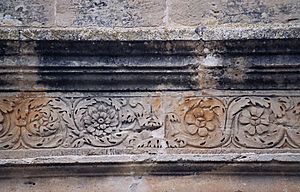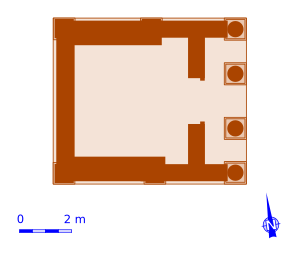Roman mausoleum of Fabara facts for kids
The Fabara Mausoleum is an ancient Roman tomb. It's also known as the Mausoleum of Lucius Aemilius Lupus. You can find it near the village of Fabara in Zaragoza, Spain, right by the Matarranya River.
This amazing tomb is one of the best-preserved Roman monuments in the whole Iberian Peninsula (that's Spain and Portugal!). The area around it has many other old Roman sites, including Roman villas (fancy country homes).
The mausoleum was built a long, long time ago, in the 2nd century AD. That's about 1,800 years ago!
For many years, not many people knew about this special building. It wasn't until 1874 that it was officially reported to the Royal Academy of History. Over time, different people owned the building. Then, in 1942, the Spanish government bought it. Even before that, in 1931, it was declared a "historical artistic monument," which means it's a very important piece of history and art. It's still in fantastic condition today!
What It Looks Like
The Fabara Mausoleum is a rectangular building. It measures about 6.85 meters long and 5.94 meters wide. It's built from sandstone blocks fitted together without any mortar (like glue). Instead, metal pieces hold the blocks tightly in place.
The building is perfectly lined up with the compass directions. Its main front and entrance face east, towards the sunrise. It looks like a classical Roman temple, a style called "prostyle." This means the front has four columns. Two of these columns are between the side walls, and two more are attached to the walls.
The other walls of the building are plain, but they have decorative flat columns called pilasters. You can see two of these on the back corners and two more in the middle of the side walls.
The Top Parts
Above the walls and columns at the front, there's a decorative band called an entablature. This part used to have an important inscription made of bronze letters. These letters were nailed onto the stone, but they are now gone. You can still see the marks where they used to be! On the sides and back of the entablature, there are cool carvings of flowers and garlands (like wreaths).
On top of the entablature, there are two triangular parts called pediments. The one at the front is a bit damaged, but it still has the inscription that helped people figure out who the tomb was for. The pediment at the back is smooth and in better shape.
Inside the Tomb
Between the columns and the front door, there's a small entrance area called a pronao. The main room inside, called the cella, has a rounded ceiling shaped like a tunnel. This is called a barrel vault.
There's also a staircase that leads down to a burial room underneath the main building. This lower room also has a barrel vault ceiling.
The Important Inscription
On the front pediment, you can still clearly read part of the inscription: L' A MILI LVPI
Experts believe that a letter "E" was probably between the "A" and "M." There are also marks above the main inscription where metal letters were once nailed. These were likely "D" and "M."
So, the full inscription might have been: D. M. L'AEMILI LVPI
This can be translated as: "To the manes gods of Lucius Aemilius Lupus." The "manes gods" were spirits of the dead in Roman belief. Lucius Aemilius Lupus was likely the person buried here, but we don't know much else about him!
See also
 In Spanish: Mausoleo de Fabara para niños
In Spanish: Mausoleo de Fabara para niños






